It turns out there's a subtle but important distinction between "Malaysian" and "Malay." The latter refers to an ethnic group and their language; the former is the name of a country composed of many ethnicities of whom the Malay are but the largest. There are large populations of both Chinese and South Asian origin, as well as indigenous groups. And naturally, all of them, plus the English and Dutch colonizers, have sprinkled their spices and poured their sauces into an extremely tasty, and surprisingly deep, melting pot. Indeed, the hardest part of this meal was choosing just a few dishes from the pantheon of dishes to represent the country.

This meal was very popular, so we tried out a two-table arrangement for the first time. We were fortunate to have two Malaysians in our midst: Robert, a forester from Borneo learning from his counterparts in Oregon, and Christina, the mom of our dear friend Laura, who was there with her husband Craig. Also present: Will, Caitlin, Laura, Jill and her husband, our realtors Scott and John, Dede and Chris, and Robyn, Miles, and Aliza.
Teh tarik | Black tea with condensed milk
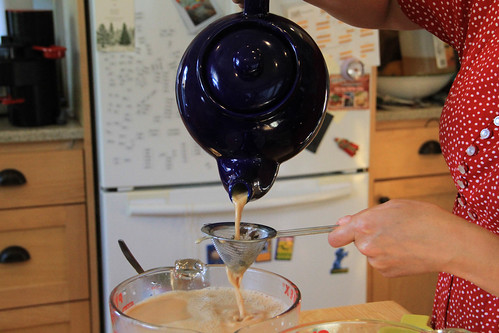
Brew some black tea (the cheap crumbly kind, not the fancy leafy type; normal stuff in a teabag is fine), mix it with a lot of condensed milk, and pour it in a thin stream back and forth between heat-resistent pitchers — after all, "tarik" means "pull," which is what you're doing. The milky-sweet tea will cool off to drinking temperature as you pour it back and forth, and get all wonderfully frothy. Yum.
Nasi lemak | Coconut rice with garnishes | Recipe
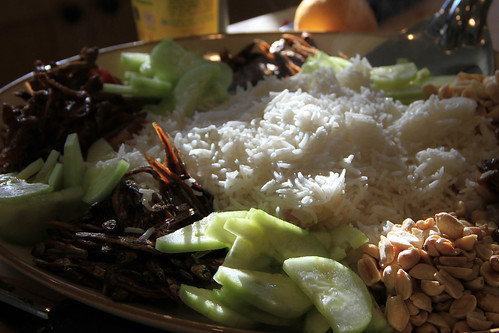
This dish is hugely popular in several countries in the area, and Malaysia claims it as a national dish. It can be eaten anytime, hot or room temperature, and usually for breakfast. The name means "fat rice," referring to the rich coconut milk in which the rice is cooked, but this dish is much more than that. While there are many variations, we made the classic: a spicy sambal with tiny anchovies, and toppings of plain fried anchovies, peanuts, and cucumber to accompany.
It made for a great appetizer, an introduction to the rich coconut and spicy sambal flavors we'd encounter throughout the meal. The crispy garnishes were fun nibbles between more substantial bites while listening to a room of sixteen people introduce themselves.
Christine’s curries
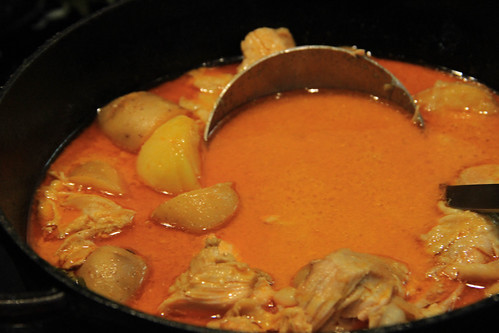
Christine made two curries: one in the style of the South Asian population, the other more of a Nyonya (Chinese) variety. She can't find the recipes. Oh well, they were tasty!
Sarawak laksa | Seafood and chicken soup | Recipe
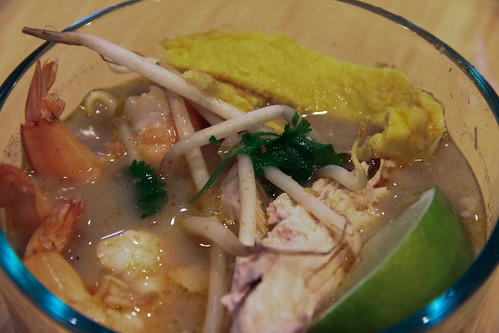
Laksa is a hugely popular dish in Malaysia and Singapore from Peranakan cuisine, the food of the descendants of Chinese migrants. While there are dozens of varieties, based around either coconut milk or a sour broth or both, what they all have in common is being a complex, usually spicy noodle soup.
The version I cooked is from Sarawak, the most westerly state on Malaysian Borneo. Peninsular Malaysia, the part between Thailand and Singapore, gets most of the attention and has most of the population. But the majority of the country's land mass lies across the South China Sea in East Malaysia, on the island of Borneo. The rich red color comes from both chilies and that near-ubiquitous shrimp paste block known as belacan, and it's a hybrid laksa in two ways: it's got both coconut and sour elements, and it features both seafood and meat.
Most Malaysians would start a laksa from a store-bought sambal paste, but given my habit I made it all from scratch. Yet despite the dozen-plus ingredients in the sambal and all herbs and meats and whatnot, I found the flavors of the soup to be fairly flat. Not bad, but just a disappointment. Was it me, or the recipe? I don't know, but I won't be making it exactly this way again.
Char kway teow | Seafood and sausage noodle stir fry
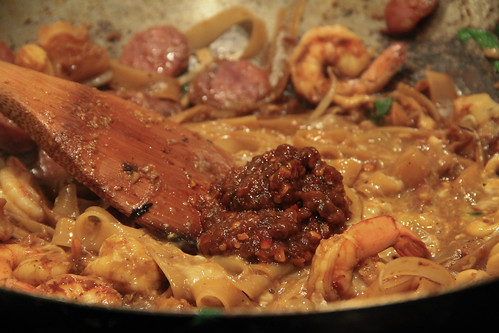
I can’t decide whether this dish is more fun to make or to eat. It’s a whole lot of work to do it from scratch, to make the sambal, prepare all the various seafood, and get all the ingredients strategically positioned. But it’s that last few minutes of a fast-moving sequence that makes this one of the most entertaining dishes I’ve ever made: start with lard, stir fry garlic and sausage, add seafood and just barely cook, throw in noodles and sauce, push the stuff to the side, add more lard, crack in eggs, roughly scramble them into the noodles, throw in that sambal you worked to hard on, and finish with bean sprouts. All that in the span of just a few minutes! It’s intense and rewarding and smells amazing.
Oh, and it tastes great too. I’m writing this as I return from two weeks in Southeast Asia, where I tried three different attempts at this dish, in Singapore and Indonesia. I’m not sure whether Malaysians just have a better style or if this recipe in particular is fantastic, but I missed the char on the noodles, the richness of the spicy-fishy sambal, the sweetness of the Chinese sausage. Maybe the difference comes down to the lard, which those halal eateries didn’t use? Dunno, but I have some sambal left over and I’m gonna make this again soon.
Agar agar gula melaka | Palm sugar and coconut jelly
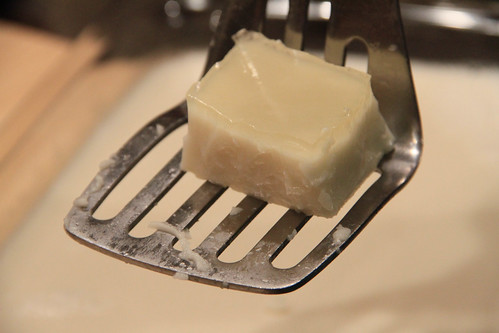
You’d think I’d have learned from the Borneo starch disaster that tapioca is not an appropriate substitute for palm sago, but no. My attempt at making a boiled dessert requiring the latter turned out to be a gloppy, tasteless mess, and was useless except for fueling my backyard compost. Thankfully, I have absorbed another lesson, which is to make dessert first, especially if it needs time to chill, so I had time to change course, and desperately searched for more Malaysian desserts.
I hit upon the Southeast Asian answer to Jell-O, and by a stroke of luck I had all the ingredients. Coconut milk was no problem as I’d bought a huge can, and I happened to have palm sugar left over from a previous meal. The agar agar, like gelatin but derived from seaweed, came from a molecular gastronomy kit Laura gave me two birthdays ago. Ten minutes later and this sweet and creamy dessert was sitting in the fridge, on its way to Jiggletown.
It was a hit! In fact, it probably went over better than my original choice would have. Being fairly intense with all that sugar and richness, a small square was enough for most, a godsend after such a big meal. Except for Aliza, who couldn’t get enough of it, and after eating several portions took the leftovers home.